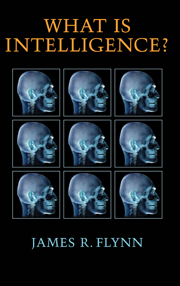Book contents
- Frontmatter
- Contents
- List of figures
- List of tables
- List of boxes
- Preface to the expanded paperback edition
- Acknowledgments
- 1 A bombshell in a letter box
- 2 Beyond the Flynn effect
- 3 Towards a new theory of intelligence
- 4 Testing the Dickens/Flynn model
- 5 Why did it take so long?
- 6 IQ gains can kill
- 7 What if the gains are over?
- 8 Knowing our ancestors
- 9 The art of writing cognitive history
- 10 About GUT: the grand unification theory of intelligence
- 11 Howard Gardner and the use of words
- Appendix I Tables
- Appendix II Declaration in a capital case
- References
- Subject index
- Name index
10 - About GUT: the grand unification theory of intelligence
Published online by Cambridge University Press: 05 August 2012
- Frontmatter
- Contents
- List of figures
- List of tables
- List of boxes
- Preface to the expanded paperback edition
- Acknowledgments
- 1 A bombshell in a letter box
- 2 Beyond the Flynn effect
- 3 Towards a new theory of intelligence
- 4 Testing the Dickens/Flynn model
- 5 Why did it take so long?
- 6 IQ gains can kill
- 7 What if the gains are over?
- 8 Knowing our ancestors
- 9 The art of writing cognitive history
- 10 About GUT: the grand unification theory of intelligence
- 11 Howard Gardner and the use of words
- Appendix I Tables
- Appendix II Declaration in a capital case
- References
- Subject index
- Name index
Summary
I have done some more thinking about the task of unifying knowledge of cognitive abilities on the individual differences, social trends, and brain physiology levels. On page 83, I believe I went astray in my scenario of how this might be done. I outlined three steps: (1) a model integrating the factors that cause cognitive trends over time (from the social level) with what cause individual differences – a task done tentatively by the Dickens/Flynn model; (2) a model integrating individual differences with brain physiology using something similar in nature to the Dickens/Flynn model; (3) then a super-model that would integrate the preceding two.
This overlooks a central fact: minds solve cognitive problems and brains do not. Both the social level and the individual differences level feature minds solving problems, the first with minds evolving over time, the second with individual minds operating in conjunction with one another within a generation. Therefore, these two levels cry out for integration. The relation of the brain to both of these levels is different. It is the biological substratum that underlies them both and, therefore, it sets the task of reducing what is going on in the mind to what is going on in the brain. In other words, bringing the brain into a total picture of intelligence operating on all three levels requires a reductionist model, rather than an integrative model akin to Dickens/Flynn. Seeking something like the latter would be both impossible and unnecessary.
Information
- Type
- Chapter
- Information
- What Is Intelligence?Beyond the Flynn Effect, pp. 197 - 202Publisher: Cambridge University PressPrint publication year: 2007
